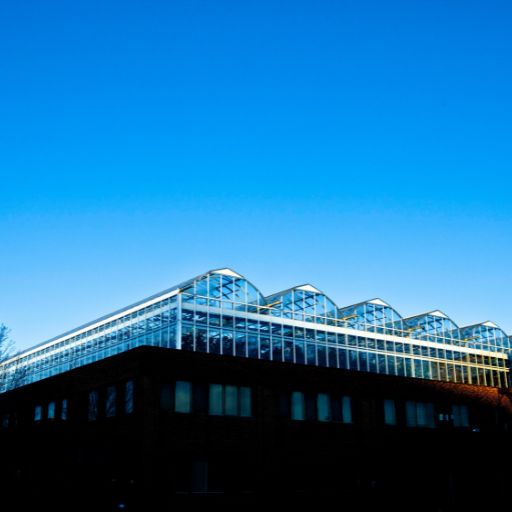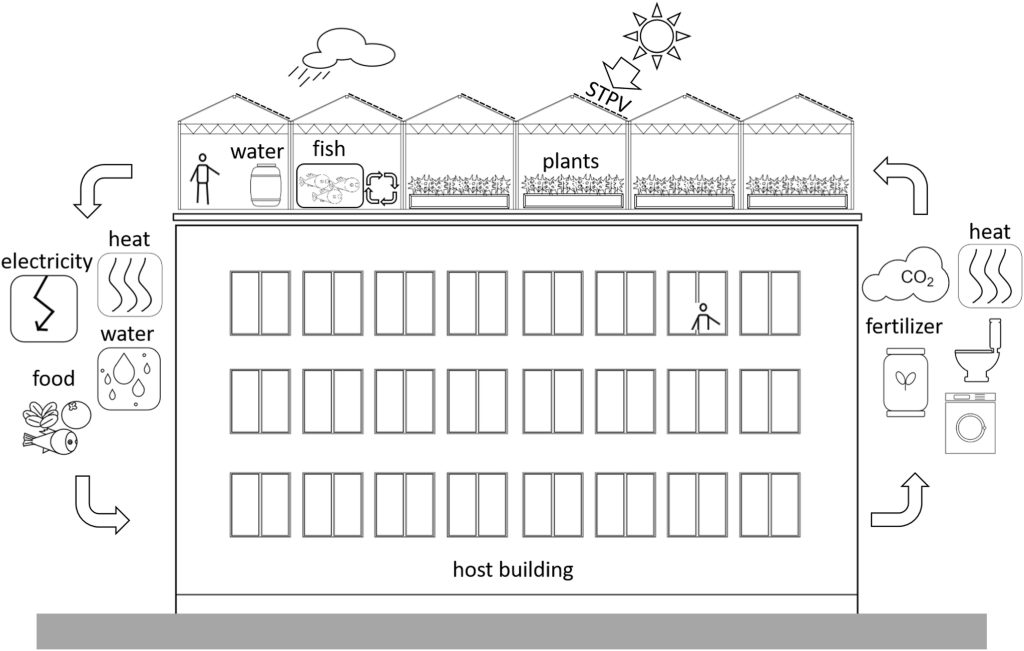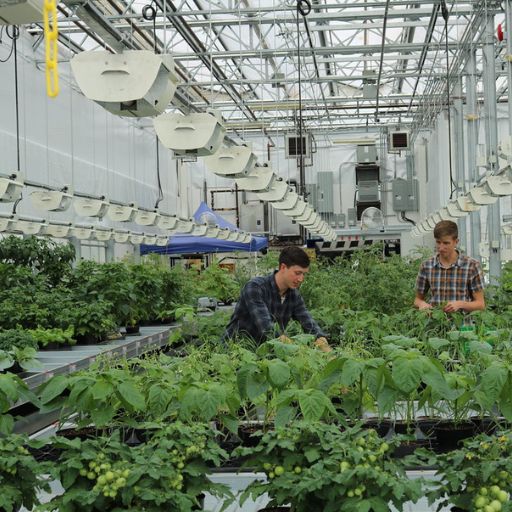Article-at-a-Glance
- Smart greenhouse rooftop farming utilizes advanced technology to optimize space and resources for urban agriculture.
- Key technologies include climate control, irrigation systems, and data analytics to improve plant growth and yield.
- Starting a rooftop garden requires understanding the basics of greenhouse setup, plant selection, and water management.
- Vertical farming and hydroponic systems are innovative solutions for maximizing yield in small spaces.
- Smart greenhouses contribute to sustainability by reducing waste, managing stormwater, and providing local, fresh produce.
Green Thumbs Up High: Smart Greenhouses Transform Rooftops
Imagine a bustling cityscape, where amidst the concrete jungle, there’s a lush oasis thriving above. That’s right, rooftops are no longer just idle spaces, they’re turning into verdant plots of productivity, thanks to smart greenhouse technology. And it’s not just about adding a splash of green, it’s a full-fledged agricultural revolution taking root in the sky.
Seeding the Sky: How Rooftops Are Becoming Gardens
Why rooftop farming, you ask? Well, as our urban areas expand, we’re running out of space. But look up, and you’ll see miles of unused rooftops, just waiting to be transformed into vibrant gardens. It’s not just about beautifying the city, it’s a matter of food security, sustainability, and community.
But not just any kind of farming will do up here, we’re talking about smart greenhouse rooftop farming. This isn’t your grandma’s backyard plot, it’s high-tech, efficient, and incredibly productive. Smart greenhouses use the latest in agricultural tech to create perfect growing conditions for plants, all year round.
Most importantly, they’re designed to make the most of limited space and resources. Because let’s face it, on a rooftop, every square inch and every drop of water counts. That’s why these greenhouses are equipped with systems to control temperature, humidity, and light, as well as to collect and recycle water. It’s all about growing more with less, and doing it smartly.
Smart Systems: The Tech That Makes It All Grow
So, what makes these greenhouses so smart? First off, they’re often automated. Sensors monitor everything from soil moisture to air quality, and automated systems adjust the environment accordingly. This ensures that plants get exactly what they need, when they need it, for optimal growth.
But it’s not just about automation, it’s also about data. Smart greenhouses collect heaps of data on plant growth, which can be analyzed to further improve yields. Farmers can track which varieties are thriving, how changes in the environment affect growth, and even predict when crops will be ready to harvest. It’s agriculture meets big data, and it’s changing the way we grow food.
And then there’s the issue of water. In a city, water is precious, and smart greenhouses are designed to use it wisely. They often incorporate rainwater harvesting and closed-loop irrigation systems, which means less waste and lower water bills. In some cases, they can even purify and reuse greywater from the building below. It’s a win-win for farmers and the environment.
Now, let’s dive a bit deeper. You’ve got the vision, the drive, and a rooftop space. What’s next? You’ll need to roll up your sleeves and get your hands dirty—figuratively, of course, because in smart greenhouses, dirt is optional!

“Lufa Farms Montreal rooftop …”
Technology at the Root: Automation and Data Analytics
It’s time to talk about the roots of the operation—quite literally. The success of a smart greenhouse lies in the technology that supports it. This isn’t just about planting seeds and hoping for the best. It’s about creating an environment where plants are guaranteed to flourish.
Sensor Savvy: Tracking Plant Needs in Real-Time
At the heart of a smart greenhouse, you’ll find a network of sensors. These aren’t your average gadgets, they’re the eyes and ears of your operation. They track temperature, humidity, light levels, and soil conditions. But it’s not enough to just collect this data, you’ve got to use it. These sensors allow you to respond to your plants needs in real-time, adjusting the environment to keep them happy and healthy.
For example, if the sensors detect that the air is too dry, an automated system can kick in to mist the plants, raising the humidity to the perfect level. It’s like having a greenhouse that talks to the plants, finds out what they need, and then delivers it without you having to lift a finger.
Climate Controlled: Customizing Your Greenhouse Environment
What is the coolest things about smart greenhouses? You’re in control of the weather—well, the indoor weather, at least. Whether it’s scorching hot or freezing cold outside, your plants will remain oblivious, basking in their ideal climate. This is crucial because consistent conditions lead to consistent yields. And in the world of urban agriculture, consistency is key.
Imagine it’s the dead of winter, but inside your greenhouse, it’s a balmy spring day. That’s the magic of climate control. By maintaining the perfect temperature and humidity year-round, you can grow summer crops even when there’s snow on the ground. And that means fresh tomatoes in December, which is pretty remarkable if you think about it.
Data-Driven Farming: Using Analytics to Boost Harvests
But wait, there’s more! With all the data your sensors are collecting, you’ve got a goldmine of information at your fingertips. This data can help you understand exactly what’s working and what’s not. You can identify patterns, predict outcomes, and make informed decisions that will boost your harvests.
For instance, you might notice that your lettuce grows best when the humidity is at 60%, or that your herbs produce more oil when they get a little extra light. By analyzing this data, you can fine-tune your greenhouse conditions to maximize both yield and quality. It’s like having a cheat code for farming.
Composting and Waste: Circular Sustainability Above Streets
Let’s talk trash—specifically, how smart greenhouses can turn it into treasure. Waste management is a big deal in urban areas, and smart greenhouses can play a pivotal role in creating a more sustainable city.

Integrated rooftop greenhouse (IRTG), using heat and respired CO2 from host building
From Scraps to Soil: Composting in Confined Spaces
First up, composting. You might think you need a big backyard to compost, but that’s not the case. In a rooftop greenhouse, you can set up a compact composting system that turns kitchen scraps and plant waste into rich, nutritious soil. It’s a closed-loop system that not only reduces waste but also improves your plants health.
And the best part? It’s not complicated. You just need a bin, some worms, and a bit of know-how. The worms do most of the work, breaking down organic material into compost that’s like a superfood for your plants. Plus, it’s a great way to get rid of those veggie peels and coffee grounds without sending them to the landfill.
Green Waste Management: The Loop of Nutrients
But composting is just one piece of the puzzle. Smart greenhouses can also incorporate systems for managing green waste, like leaves and stems that are trimmed from plants. Instead of tossing them out, you can shred them and add them to your compost, or use them as mulch. This keeps nutrients in the system, where they belong, and helps to conserve water by reducing evaporation.
It’s all about thinking in cycles. In nature, there’s no waste—everything gets reused. By mimicking these natural cycles, smart greenhouses can help make cities more sustainable, one rooftop at a time.
Harvesting the Height: The Bounty of Rooftop Farming
Now, for the moment we’ve all been waiting for: harvest time. This is when you get to reap the rewards of all your hard work. But in a smart greenhouse, even harvesting is high-tech.
Picking the Produce: When and How to Harvest
Thanks to all the data you’ve been collecting, you’ll know exactly when your crops are at their peak. Sensors can help you determine the perfect moment to harvest, ensuring that your produce is as fresh and flavorful as possible. And because everything’s been growing in ideal conditions, you can expect a bumper crop.
Harvesting in a smart greenhouse is about timing and technique. You want to be gentle with the plants, to avoid damaging them. And you’ll want to plan your harvests so that you can keep a continuous supply of fresh produce coming in. It’s like a conveyor belt of deliciousness, right on your rooftop.

“View of Terramera’s rooftop greenhouse …”
The Flavor of Freshness: Marketing Your Roof-Grown Goods
So, you’ve harvested your crop—now what? It’s time to spread the word and get your fresh, roof-grown produce into the hands and hearts of city dwellers. People are seeking out local, sustainable options, and what’s more local than a rooftop farm in their neighborhood? Here’s how to start:
- Set up a stand at a local farmer’s market to sell your produce directly to consumers.
- Partner with nearby restaurants interested in featuring local, sustainable ingredients.
- Join a community-supported agriculture (CSA) program to distribute your harvest to members.
It’s about more than just selling veggies, it’s about creating a story and an experience. Your rooftop oasis is not just a farm—it’s a beacon of sustainability and a testament to what’s possible in urban spaces.
Moreover, every tomato and every leaf of basil you sell comes with a narrative of resilience and innovation. Your customers aren’t just making a purchase, they’re investing in the future of the city and taking home a piece of the rooftop revolution.
Community and Connection: Urban Farming as a Social Enterprise
Urban farming isn’t just about growing food, it’s about growing communities. Your rooftop greenhouse is a platform for education, a hub for neighborhood engagement, and a symbol of collective green efforts. Host workshops to teach kids about where their food comes from. Invite local chefs for cooking demos using your produce. Create a volunteer program for residents to get their hands dirty and learn about sustainable practices. This is more than agriculture. it’s about weaving the fabric of a tight-knit, eco-conscious community.
Frequently Asked Questions on Smart Greenhouse Rooftop Farming
What Are the Basic Requirements to Start a Rooftop Greenhouse?
To start a rooftop greenhouse, you’ll need:
- Access to a suitable rooftop space with adequate structural support for the added weight.
- Permission from the building owner or management, and compliance with local zoning and building codes.
- A greenhouse structure that can withstand the unique challenges of an urban rooftop, such as wind and varying temperatures.
- Smart greenhouse technology, including sensors and automation systems, to optimize growing conditions.
- Basic gardening tools, seeds or starter plants, and a passion for urban agriculture.
And don’t forget a solid plan for water management, waste reduction, and crop rotation to ensure a sustainable operation.
How Does Smart Technology Improve Yield in Rooftop Farming?
Smart technology is a game-changer for rooftop farming. It enhances yield by:
- Providing real-time data on plant health and environmental conditions, allowing for precise adjustments.
- Automating processes like watering and climate control, ensuring plants receive the optimal care without human error.
- Enabling year-round production through climate-controlled environments, regardless of outdoor weather conditions.
This tech-savvy approach results in healthier plants, higher yields, and a more efficient use of space and resources.
Can Any Type of Plant Grow in a Greenhouse Rooftop Farm?
While not every plant is suited for rooftop conditions, many thrive in a greenhouse setting. You can grow:
- Leafy greens like lettuce and spinach, which are resilient and grow quickly.
- Herbs such as basil, mint, and cilantro, which are in high demand for their freshness.
- Vegetables like tomatoes, peppers, and cucumbers, which benefit from the controlled environment.
- Even some fruits, like strawberries and dwarf citrus trees, can prosper with the right care.
It’s about matching the right plant to your greenhouse’s capabilities and your city’s climate.
What Are the Environmental Benefits of Rooftop Farming?
Rooftop farming is a beacon of sustainability, offering environmental benefits like sustainability:
- Reducing urban heat island effect by replacing heat-absorbing surfaces with plants.
- Improving air quality by filtering pollutants and producing oxygen.
- Managing stormwater runoff, which can reduce the burden on city drainage systems.
- Decreasing the carbon footprint associated with food transport by providing local produce.
It’s a powerful way to combat climate change, one rooftop at a time.
